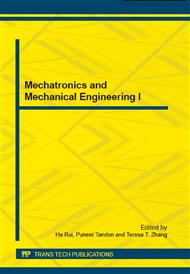[1]
Zhong Binglin, Huang Ren:Introduction to machine fault diagnosis(Mechanical Industry Publications, Beijing 2002).
Google Scholar
[2]
Aapo Hyvarinen, Juha Karhunen, Erkki Oja: Zhou Zongtan , Dong Guohua, et, al Translated: Independent component analysis( Electronic Industry Publications, Beijing 2007).
Google Scholar
[3]
Q. He, R, Du, F, Kong: Phase space feature based on independent component analysis for machine health diagnosis. Journal of Vibration and Acoustic, vol. 133(2011), 011106.
Google Scholar
[4]
X. Liu, et al: Blind source separation of internal combustion engine piston slap from other measured vibration signals. Mechanical Systems and Signal Processing , no. 19(2005), pp.1196-1208.
DOI: 10.1016/j.ymssp.2005.08.004
Google Scholar
[5]
R. Peled,S. Braun, et. al: A blind deconvolution separation of multiple sources with application to bearing diagnostics. Mechanical Systems and Signal Processing , no. 19(2005), pp.1181-1195.
DOI: 10.1016/j.ymssp.2005.08.019
Google Scholar
[6]
Wei Lu, Jagath C. Rajapakse : ICA with Reference. Neurocomputing , vol. 69(2006), pp.2244-2257.
DOI: 10.1016/j.neucom.2005.06.021
Google Scholar
[7]
W. Lu, J.C.R.: Approach and applications of constrained ICA. IEEE TRANSACTIONS ON NEURAL NETWORKS , vol. 16(2005), pp.203-212.
DOI: 10.1109/tnn.2004.836795
Google Scholar
[8]
Changli Lia, Guisheng Liaoa, Yuli Shenc: An improved method for independent component analysis with reference. Digital Signal Processing , vol. 20(2010), pp.575-580.
DOI: 10.1016/j.dsp.2009.08.009
Google Scholar
[9]
Akhtar, M. T., et al: Employing spatially constrained ICA and wavelet denoising, for automatic removal of artifacts from multichannel EEG data. Signal Processing, vol. 92 (2012), pp.401-416.
DOI: 10.1016/j.sigpro.2011.08.005
Google Scholar
[10]
Zhiyang Wang, Jin Chen, Guangming Dong, Yu Zhou: Constrained independent component analysis and its application to machine fault diagnosis. Mechanical Systems and Signal Processing, vol. 25 (2011), pp.2501-2512.
DOI: 10.1016/j.ymssp.2011.03.006
Google Scholar
[11]
Wu Chuanhui , Liang Yu, Guo Yu:Extracting fault features of rolling bearing during speed variation based on Cica. Mechanical Science and Technology, vol. 8(2013).
Google Scholar
[12]
Liang Yu, Guo Yu, Wu Chuanhui:Rolling element bearing fault feature extraction based on spectral kurtosis and cICA. Journal of Mechanical Strength , vol. 5(2013).
Google Scholar
[13]
Liu Ju, Sun Jiande, Xu Hongji: Blind signal processing theory and application (Science Publications, Beijing 2012).
Google Scholar
[14]
A. Hyvärinen: Fast and robust fixed-point algorithms for independent component analysis. IEEE Transactions on Neural Networks , vol. 10 (3) (1999) , pp.626-634.
DOI: 10.1109/72.761722
Google Scholar
[15]
Nguyen Duc Thanga, Tahir Rasheeda, Young-Koo Leea, Sungyoung Leea, Tae-Seong Kimb: Content-based facial image retrieval using constrained independent component analysis. Information Sciences, vol. 181 (2011), pp.3162-3174.
DOI: 10.1016/j.ins.2011.03.021
Google Scholar


